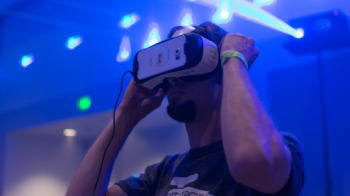Five futuristic technology predictions for digital marketing and ecommerce
Sri Sharma
Co-founder of Increasingly, Sri Sharma, gives his five predictions for digital marketing and e-commerce in the future
I was fortunate to spend part of 2016 with Singularity University at NASA’s research centre in Silicon Valley. I was there along with 79 other technologists and entrepreneurs from across the globe on a Google-awarded scholarship to explore how to positively impact a billion lives using technology.
Whilst I was there, immersing myself in cutting edge technologies, including artificial intelligence, robotics, nanotechnology, digital biology and other technologies of tomorrow, I couldn’t help but draw connections to the industries I know in digital marketing and e-commerce. I started to observe key trends regarding where I believe these sectors are heading and wanted to share these ideas.
So what does the accelerated impact of technology on society mean for the next five years in e-commerce and digital marketing? Furthermore, where are the opportunities in the nearer term? Here are my top five predictions:
1.Mixed reality and voice will be how we shop in the future
Mixed reality is defined as applying augmented reality (AR) to our physical world. With recent advances in technology, the time has now come for it to take centre stage. Facebook announced the coming of Facebook glasses at their recent F8 Developer conference, and on top of that, we have the top-secret MagicLeap and the soon-to-be-launched Microsoft Hololens.
Voice in the home is not simply going to be important—it’s going to be how you control your home activity. And now, joining the ranks of Amazon Echo and Google Home, China’s version, DingDong, has newly launched.
So why is this important for e-commerce? When I use Amazon Echo in my home, I’m just not comfortable with the concept of simply talking to it and buying products. I want to see products before I buy. Well, imagine that you could use voice command to materialise 3-dimensional objects, overlaid on the physical world around you. In your living room, you magically conjure up purchasable products right in front of your eyes.
In the home setting, I believe we will indeed see mixed reality and voice go hand in hand. You’ll literally use voice command to materialise a viewable purchasable product—pinch, expand, flip, then say, ‘Buy !’. This isn’t as futuristic as you may think. Microsoft Hololens have carried out tests of visualising the Volvo in 3D, using their Hololens technology. Now imagine the car materialised in your driveway, where it would live. You open it, view the engine, test different colours for the exterior and interior. Then you say, ‘Buy!’ Not so many years ago, we marvelled at people buying beds on mobile phones. What I am predicting will become normal one day.
Online shopping will be reinvented and in the future, eyewear won’t be needed at all. We’ll be talking about ‘interfaces’, not just ‘screens’. Plugging into ecosystems such as Echo’s will enable startups and brands alike to take advantage of this next wave.
2.Delegation of work to your mobile
We all have supercomputers in our pockets, but today we use them as simple tools. Tomorrow, we’ll use them as partners to delegate work to.
This will be enabled by the dawn of personal assistants, and all the big names have their hand in this world: Cortana from Microsoft, Assistant (formerly Now) from Google, Siri from Apple and M from Facebook. It’s also good to see smaller smart players such as Hound and Viv.
Viv is a really interesting case. Their founders were the team who developed Siri, and they have already sold the business to Samsung. Watching their demo this summer, I got a glimpse of how they are trying to play out their mission to radically simplify the world by providing an intelligent interface to everything. With an open architecture for third-party products and services, you can say, ‘Pay Steve £20,’ and with one click to confirm, it’s done. So, by 2017, we can expect the ability to undertake more complex shopping research such as, ‘Find me three of the best waterproof boots for under £75, and on offer.’
Why is this important for e-commerce? Well, crucially, personal assistants will firstly be used to save consumers time. If a computer is doing your product research for you, price and ratings will become even more important. After all, a computer doesn’t care about inspiration and experience. We will see a rise in traffic to marketplaces such as Google Shopping and Amazon. Plugging into open-architecture products such as Samsung’s Viv will enable brands to connect with customers in ways unimagined today.
3.Super intelligence becomes a utility
Only four years ago, Google’s Artificial Intelligence (AI) capability struggled to comprehend the difference between a cat and a dog on YouTube. Today, some of Google’s search rankings algorithms are updated by AI rather than by a smart human. Facebook, earlier this year, announced that their AI capability DeepFace is now better at facial recognition than a human. This really is moving at an exponential pace.
AI, with its super intelligence, is fast becoming a utility where we are able to pay a small fee per use, just as we would buy small blocks of cloud computing power cheaply on Amazon Web Services. It’s also becoming democratised. Google, Facebook and Amazon have all launched opensource toolkits for their AI and Machine Learning (ML) capabilities, and companies such as Kaggle are enabling businesses to run competitions for data scientists to solve challenges.
There is an opportunity for e-commerce players to use democratised AI and ML to utilise their data, learn more about what their customers want, and generate increased revenue and loyalty. Companies such as Increasingly, which I cofounded, are leveraging this democratisation of AI. Our product is harnessing machine learning to grow average order value for e-commerce retailers.
4. Robots will transform consumer shopping
Tomorrow we are going to see robots prevalent in our factories, homes, schools, old age homes, and even stores.
Take Fellow Robot, a company I met on campus at NASA. They have a partnership with Lowes, the US hardware chain, in which they provide in-store robots. The robots greet you as you walk in, guide you to what you are looking for, and if it is unavailable, help you order it online then and there. This is really interesting technology to me, because of the potential to have a truly data-centric in-store experience that is connected to online. For example, you will easily be able to match the physical visitor to the online visitor and remarket to them.
Amazon Go was also launched as a concept last month. It entirely automates the in-store experience using sensors and machine learning.
Convenient user experience and efficiency gains are clearly positives to robotics and machine learning in our stores, but there are also implications for retail workers. I researched the wider negative implications of what’s known as technological unemployment, and their solutions, here.
5. Driverless cars, free time and cheaper prices
Earlier this year, Uber announced that driverless taxis would cost one-tenth of the cost of taxis with drivers. Cost reduction is also the vision for transportation of goods by Otto, a driverless truck company that Uber just acquired.
In a world of cheaper transportation of goods and local manufacturing using 3D printing, the cost of goods sold is set to decrease for retailers. If this is passed on to consumers, we will see cheaper prices.
From a consumer perspective, cheaper goods and increased free time as we are chauffeured around in driverless cars means consumer buying patterns are set to change. For starters, the Monday morning spike in conversions could move to Sunday night, as you’re driven home.
Technology is impacting society at an exponential rate and affecting countless industries. Without a doubt, e-commerce and digital marketing will change. This presents huge opportunities to those who both understand the future and time it right.
Related content
Adbrain: Demystifying Cross-Device
Learn moreVirtual reality experiences increasing
Learn more85% of UK businesses to invest in AI by 2020
Learn moreFirst-of-its-kind hyper reality experience to accompany new Star Wars film
Learn more
Fast forward to 2030 with Futurescape
An in-depth exploration of the attitudes, innovations and media shifts that will shape the years ahead and redefine how we advertise by the turn of the decade



